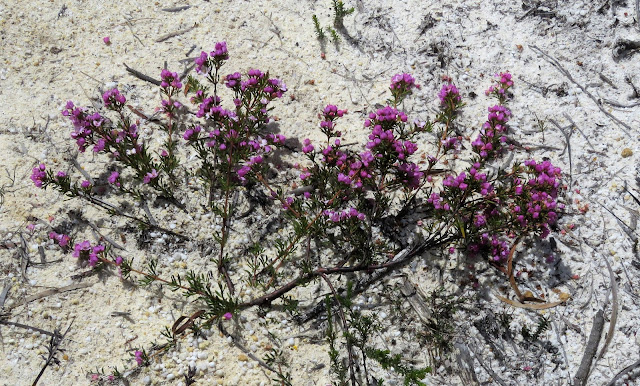Hairless Boronia a safe bet, for now
Boronia today has 133 species, with 127 found only in Australia and six in New Caledonia. This is after 20 or so species were moved across to Cyanothamnus, to make Boronia a natural group (containing all descendants of a common ancestor).
To identify species of Boronia you usually first look at the leaf shape, and for hairs or adornments on the leaves and stems. Then it's often detail of the inner flower.
The leaves in these specimens are a little hard to decipher but they are pinnate (with pairs of opposite leaflets) and rather succulent (chunky). Like many boronias, the leaves smell 'mildly unpleasant' when crushed (other species do more so).
After panicking for a while about the lack of hairs on what otherwise seemed to be the Hairy Boronia, Boronia pilosa (subspecies pilosa) - and 'pilosa' means hairy - I discovered there is much variation in this feature across its range in South Australia, Victoria and Tasmania.
Most plants from northern Tasmania have - according to Marco Duretto's 2003 revision of Boronia - 'hispidulous' stems. This means they are covered in very short, stiff hairs, as you can see (just) in the following picture. Not obviously hairy though.And the leaves may be completely hairless. This too is typical for the populations in Tasmania 'north of Freycinet Peninsula'.
The variation in this species has vexed botanists since 1840, when William Hooker reduced Jacques Labillardière's Boronia pilosa to a variety of another (Western Australian) species, only to be reversed 15 years later by his son, Joseph Hooker.
Subsequent botanists from Victoria and Tasmania have attempted to make sense of this group with little success. Marco, in his 2003 paper, confesses that his recognition of four subspecies of Boronia pilosa (and associated fine tuning of related species) is 'by no means definitive'.
So I'm happily calling my plants Boronia pilosa subspecies pilosa. This is more or less consistent with the Flora of Tasmania Online and VicFlora. As things stand.






Comments